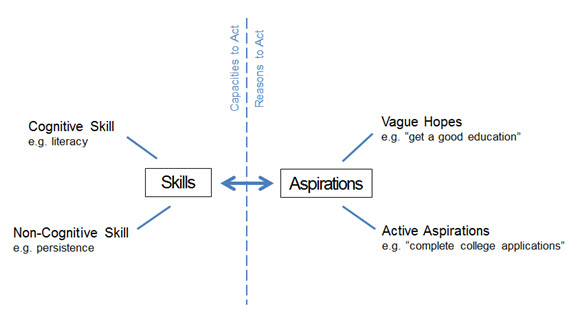Skills—cognitive and non-cognitive—provide us with what James Heckman calls the “capacities to act.” But we need reasons to act, too.
That is why JFK, in a 1963 speech on civil rights, insisted: “every American has…the equal right to develop their talent and their ability and their motivation, to make something of themselves” [emphasis added].
Social mobility requires action on the part of policy-makers, to broaden the range of opportunities available to people. But it requires action from individuals, too: to seize those opportunities.
No Culture Gap in Life Values
Americans share the same essential aspirations and values. There is little sign of a “culture gap” between social classes, at least among high school seniors:

Vague Hopes and Active Aspirations
But there is a big difference between a general aspiration with little palpable impact on a person’s conduct and a strongly grounded aspiration, towards which an individual is actively working and planning. In a paper presented at the recent INET annual conference, “vague hopes” and “active aspirations” (you can watch the presentation here, my contribution is 1.09 minutes in).
- An active aspiration is a goal towards which a person is consciously and deliberately working. It requires investments of time, energy and other resources; and often, additionally, the ability to resist or defer gratification. Getting to college, for example, is likely to require study; and this will necessarily reduce the opportunities to party with friends.
- A vague hope consists of a loosely-stated goal or set of goals, largely untethered from current activities and decision-making. A teenager may hope for a college degree, but doesn’t really work at school, investigate colleges, or in some cases, even apply.

Class Gap in Active Aspirations: Education
There may not be a class gap in vague hopes, but it looks like there is in active aspirations. Take education. There is unanimity about the importance of a good education, and high hopes of getting to college across the social classes. But there are sizable class gaps among high school students in time devoted to homework; personal predictions of post-graduate study; and rates of college application.
High school valedictorians from working class backgrounds are much less likely to apply to a selective private college (50% versus 80%), even though their admission chances, and enrollment ratios if accepted, are at least as good (in part because of the provision of financial aid). As the author of the study concludes, “the critical factor that prevented poorer valedictorians from attending a top college was simply failing to fill out an application and click ‘Submit.’”
Why the mobility-diluting class gap in active aspirations? And what can we do about it? We’ll pick up these questions in the next blog.



Commentary
Vague Hopes and Active Aspirations, Part 1
April 15, 2014